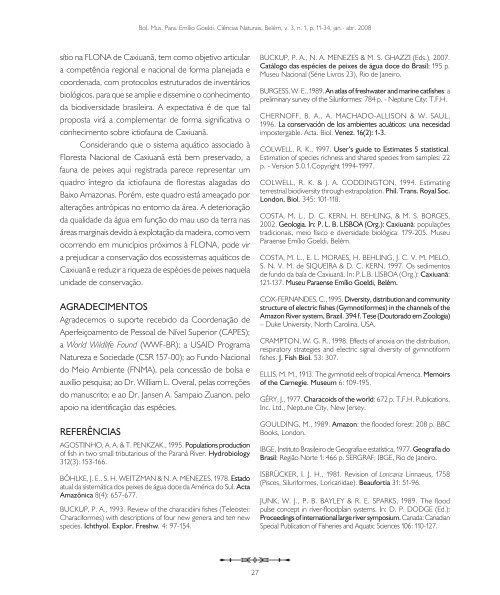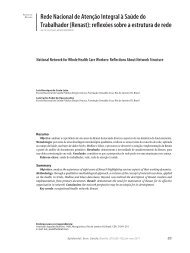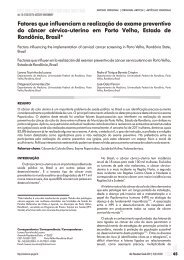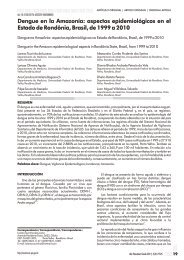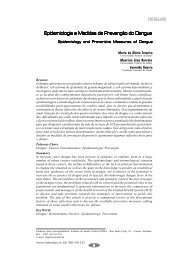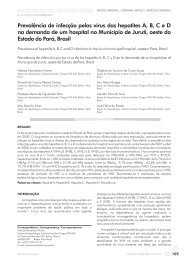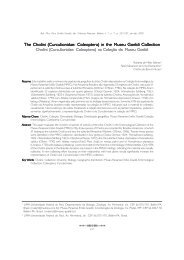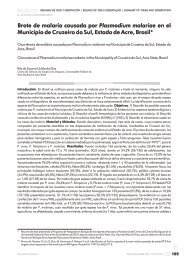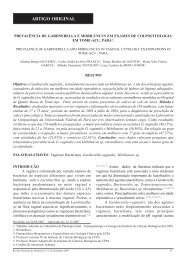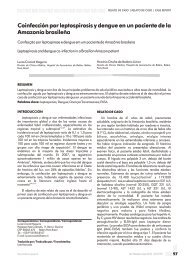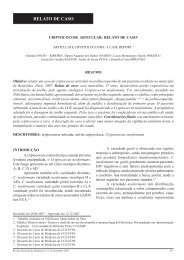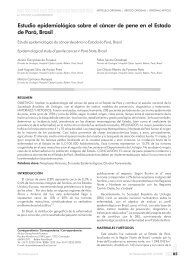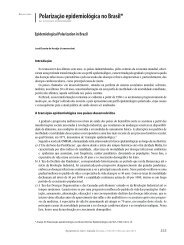Os peixes da Floresta Nacional de Caxiuanã (municÃpios de ...
Os peixes da Floresta Nacional de Caxiuanã (municÃpios de ...
Os peixes da Floresta Nacional de Caxiuanã (municÃpios de ...
Create successful ePaper yourself
Turn your PDF publications into a flip-book with our unique Google optimized e-Paper software.
Bol. Mus. Para. Emílio Goeldi. Ciências Naturais, Belém, v. 3, n. 1, p. 11-34, jan.- abr. 2008sítio na FLONA <strong>de</strong> Caxiuanã, tem como objetivo articulara competência regional e nacional <strong>de</strong> forma planeja<strong>da</strong> ecoor<strong>de</strong>na<strong>da</strong>, com protocolos estruturados <strong>de</strong> inventáriosbiológicos, para que se amplie e dissemine o conhecimento<strong>da</strong> biodiversi<strong>da</strong><strong>de</strong> brasileira. A expectativa é <strong>de</strong> que talproposta virá a complementar <strong>de</strong> forma significativa oconhecimento sobre ictiofauna <strong>de</strong> Caxiuanã.Consi<strong>de</strong>rando que o sistema aquático associado à<strong>Floresta</strong> <strong>Nacional</strong> <strong>de</strong> Caxiuanã está bem preservado, afauna <strong>de</strong> <strong>peixes</strong> aqui registra<strong>da</strong> parece representar umquadro íntegro <strong>da</strong> ictiofauna <strong>de</strong> florestas alaga<strong>da</strong>s doBaixo Amazonas. Porém, este quadro está ameaçado poralterações antrópicas no entorno <strong>da</strong> área. A <strong>de</strong>terioração<strong>da</strong> quali<strong>da</strong><strong>de</strong> <strong>da</strong> água em função do mau uso <strong>da</strong> terra nasáreas marginais <strong>de</strong>vido à explotação <strong>da</strong> ma<strong>de</strong>ira, como vemocorrendo em municípios próximos à FLONA, po<strong>de</strong> vira prejudicar a conservação dos ecossistemas aquáticos <strong>de</strong>Caxiuanã e reduzir a riqueza <strong>de</strong> espécies <strong>de</strong> <strong>peixes</strong> naquelauni<strong>da</strong><strong>de</strong> <strong>de</strong> conservação.AGRADECIMENTOSAgra<strong>de</strong>cemos o suporte recebido <strong>da</strong> Coor<strong>de</strong>nação <strong>de</strong>Aperfeiçoamento <strong>de</strong> Pessoal <strong>de</strong> Nível Superior (CAPES);a World Wildlife Found (WWF-BR); a USAID ProgramaNatureza e Socie<strong>da</strong><strong>de</strong> (CSR 157-00); ao Fundo <strong>Nacional</strong>do Meio Ambiente (FNMA), pela concessão <strong>de</strong> bolsa eauxílio pesquisa; ao Dr. William L. Overal, pelas correçõesdo manuscrito; e ao Dr. Jansen A. Sampaio Zuanon, peloapoio na i<strong>de</strong>ntificação <strong>da</strong>s espécies.REFERÊNCIASAGOSTINHO, A. A. & T. PENKZAK., 1995. Populations productionof fish in two small tributarious of the Paraná River. Hydrobiology312(3): 153-166.BÖHLKE, J. E., S. H. WEITZMAN & N. A. MENEZES, 1978. Estadoatual <strong>da</strong> sistemática dos <strong>peixes</strong> <strong>de</strong> água doce <strong>da</strong> América do Sul. ActaAmazônica 8(4): 657-677.BUCKUP, P. A., 1993. Review of the characidiini fishes (Teleostei:Characiformes) with <strong>de</strong>scriptions of four new genera and ten newspecies. Ichthyol. Explor. Freshw. 4: 97-154.BUCKUP, P. A., N. A. MENEZES & M. S. GHAZZI (Eds.), 2007.Catálogo <strong>da</strong>s espécies <strong>de</strong> <strong>peixes</strong> <strong>de</strong> água doce do Brasil: 195 p.Museu <strong>Nacional</strong> (Série Livros 23), Rio <strong>de</strong> Janeiro.BURGESS, W. E., 1989. An atlas of freshwater and marine catfishes: apreliminary survey of the Siluriformes: 784 p. - Neptune City: T.F.H.CHERNOFF, B. A., A. MACHADO-ALLISON & W. SAUL,1996. La conservación <strong>de</strong> los ambientes acuáticos: una necesi<strong>da</strong>dimpostergable. Acta. Biol. Venez. 16(2): 1-3.COLWELL, R. K., 1997. User’s gui<strong>de</strong> to Estimates 5 statistical.Estimation of species richness and shared species from samples: 22p. - Version 5.0.1.Copyright 1994-1997.COLWELL, R. K. & J. A. CODDINGTON, 1994. Estimatingterrestrial biodiversity through extrapolation. Phil. Trans. Royal Soc.London, Biol. 345: 101-118.COSTA, M. L., D. C. KERN, H. BEHLING, & M. S. BORGES,2002. Geologia. In: P. L. B. LISBOA (Org.): Caxiuanã: populaçõestradicionais, meio físico e diversi<strong>da</strong><strong>de</strong> biológica: 179-205. MuseuParaense Emílio Goeldi, Belém.COSTA, M. L., E. L. MORAES, H. BEHLING, J. C. V. M. MELO,S. N. V. M. <strong>de</strong> SIQUEIRA & D. C. KERN, 1997. <strong>Os</strong> sedimentos<strong>de</strong> fundo <strong>da</strong> baía <strong>de</strong> Caxiuanã. In: P.L.B. LISBOA (Org.): Caxiuanã:121-137. Museu Paraense Emílio Goeldi, Belém.COX-FERNANDES, C., 1995. Diversity, distribution and communitystructure of electric fishes (Gymnotiformes) in the channels of theAmazon River system, Brazil. 394 f. Tese (Doutorado em Zoologia)– Duke University, North Carolina, USA.CRAMPTON, W. G. R., 1998. Effects of anoxia on the distribution,respiratory strategies and electric signal diversity of gymnotiformfishes. J. Fish Biol. 53: 307.ELLIS, M. M., 1913. The gymnotid eels of tropical America. Memoirsof the Carnegie. Museum 6: 109-195.GÉRY, J., 1977. Characoids of the world: 672 p. T.F.H. Publications,Inc. Ltd., Neptune City, New Jersey.GOULDING, M., 1989. Amazon: the floo<strong>de</strong>d forest: 208 p. BBCBooks, London.IBGE, Instituto Brasileiro <strong>de</strong> Geografia e estatística, 1977. Geografia doBrasil: Região Norte 1: 466 p. SERGRAF; IBGE, Rio <strong>de</strong> Janeiro.ISBRÜCKER, I. J. H., 1981. Revision of Loricaria Linnaeus, 1758(Pisces, Siluriformes, Loricarii<strong>da</strong>e). Beaufortia 31: 51-96.JUNK, W. J., P. B. BAYLEY & R. E. SPARKS, 1989. The floodpulse concept in river-floodplain systems. In: D. P. DODGE (Ed.):Proceedings of international large river symposium. Cana<strong>da</strong>: CanadianSpecial Publication of Fisheries and Aquatic Sciences 106: 110-127.27


